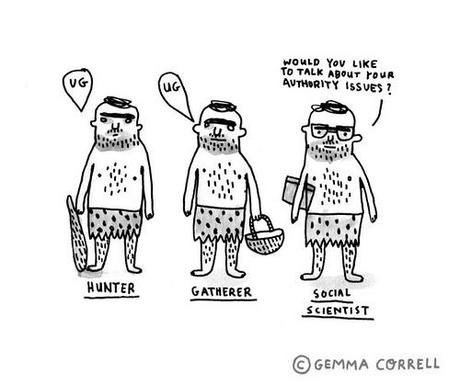Though I’m not much for New Year’s resolutions, if I had to choose one for 2013 it would be this: do not make the mistake of believing that our conceptual taxonomies are universal or timeless. We often fall into the bad habit of thinking that the ways in which we parcel and describe things make them real — that these “things” actually exist “out there” independent of our culturally patterned ideas about them. In other words, let’s resolve not to reify our categories as universals!
This is an issue that has been most notably addressed in the debates over the Diagnostic and Statistical Manual of Mental Disorders (“DSM”), which WEIRD (white, educated, industrialized, rich, democratic) people treat as a secular-clinical bible. We get diagnosed and assume that the statistically specified and insurance coded disorder must have some biological (and hence universal) basis. We rarely stop to consider the ways in which these classifications are culture bound. As Thakker and others have observed, this is questionable:
Despite inclusion of culture-bound syndromes in the DSM-IV, we argue that there still appears to be an implicit assumption that the diagnostic categories represent universal disorders. Yet many theorists argue that such disorders represent a predominantly Western illness perspective and that, therefore, the latest manual may not be universally applicable. Historically classification in clinical psychology and medicine has been notably under-researched and little attention has been paid to its guiding theory or to the suitability of this theory. This is exemplified by the DSM-IV, which avoids any explication of its theoretical basis, yet appears to assume the validity of a biomedical model of mental disorders. According to this model, mental disorders are fundamentally biological in origin, and, given the common physiology of Homo sapiens worldwide, psychopathology will be essentially homogenous, with only superficial variation in presentation across peoples. We argue that the prima facie acceptance of the biomedical approach to the understanding of psychopathology is problematic, given that mental disorders have been shown to vary significantly across cultures.
Research on the manifestation of schizophrenia across cultures has revealed some important differences, leading to the conclusion that the universality of this disorder has not been empirically demonstrated. Nor has the universality of depression been demonstrated. Studies such as those conducted by WHO, which utilized a core symptom approach, found widespread incidence of such symptoms, although the methodological weaknesses of this research reduces the force of its findings. Moreover, the overall impression created by these core symptoms does not match the picture of schizophrenia presented DSM-IV.
If major disorders such as schizophrenia and depression are in some ways culture-bound and exhibit cross-cultural variability, then it stands to reason that more inchoate concepts — such as “personality dimensions” — are even more so. Western psychologists have long assumed that the five personality traits — openness, conscientiousness, extraversion, agreeableness and neuroticism — are universal. I’ve never paid much attention to this poppy-feeling taxonomy until now, but the last item makes me particularly suspicious. Neuroticism isn’t something that springs to mind when reading the hunter-gatherer ethnohistoric record. If members of the Harvard Kalahari project had administered standard tests and measured the neuroticism of Bushmen, we would have learned a great deal about ourselves and probably nothing about them.
So we shouldn’t be surprised by a new study, announced by the American Psychological Association, which shows that these traits can’t be fitted onto foragers:
Five personality traits widely thought to be universal across cultures might not be, according to a study of an isolated Bolivian society. Researchers who spent two years looking at 1,062 members of the Tsimane culture found that they didn’t necessarily exhibit the five broad dimensions of personality – openness, conscientiousness, extraversion, agreeableness and neuroticism – also known as the “Big Five.”
While previous research has found strong support for the Big Five traits in more developed countries and across some cultures, these researchers discovered more evidence of a Tsimane “Big Two:” socially beneficial behavior, also known as prosociality, and industriousness. These Big Two combine elements of the traditional Big Five, and may represent unique aspects of highly social, subsistence societies.
I’m even a bit suspicious of reducing these traits to two in ways that westerners can readily apprehend. As Henrich, Heine, and Norenzayan noted in their instant-classic 2010 paper, what applies to us doesn’t always apply to them. In other words, we are truly the weirdest people in the world:
Behavioral scientists routinely publish broad claims about human psychology and behavior in the world’s top journals based on samples drawn entirely from Western, Educated, Industrialized, Rich, and Democratic (WEIRD) societies. Researchers – often implicitly – assume that either there is little variation across human populations, or that these “standard subjects” are as representative of the species as any other population. Are these assumptions justified?
Here, our review of the comparative database from across the behavioral sciences suggests both that there is substantial variability in experimental results across populations and that WEIRD subjects are particularly unusual compared with the rest of the species – frequent outliers. The domains reviewed include visual perception, fairness, cooperation, spatial reasoning, categorization and inferential induction, moral reasoning, reasoning styles, self-concepts and related motivations, and the heritability of IQ.
The findings suggest that members of WEIRD societies, including young children, are among the least representative populations one could find for generalizing about humans. Many of these findings involve domains that are associated with fundamental aspects of psychology, motivation, and behavior – hence, there are no obvious a priori grounds for claiming that a particular behavioral phenomenon is universal based on sampling from a single subpopulation. Overall, these empirical patterns suggests that we need to be less cavalier in addressing questions of human nature on the basis of data drawn from this particularly thin, and rather unusual, slice of humanity.
The bottom line here is that we need to be extremely cautious with WEIRD research results, many of which have been used by evolutionary religious scholars to generalize about the Paleolithic past. To take but one example (among many), Jesse Bering argues that the Princess Alice experimental effect would have been operative in our evolutionary past, and that our ancestors would have responded to invisible agent surveillance in the same way that WEIRD kids do. In light of the above (and the relevant ethnohistory), this seems unlikely.



